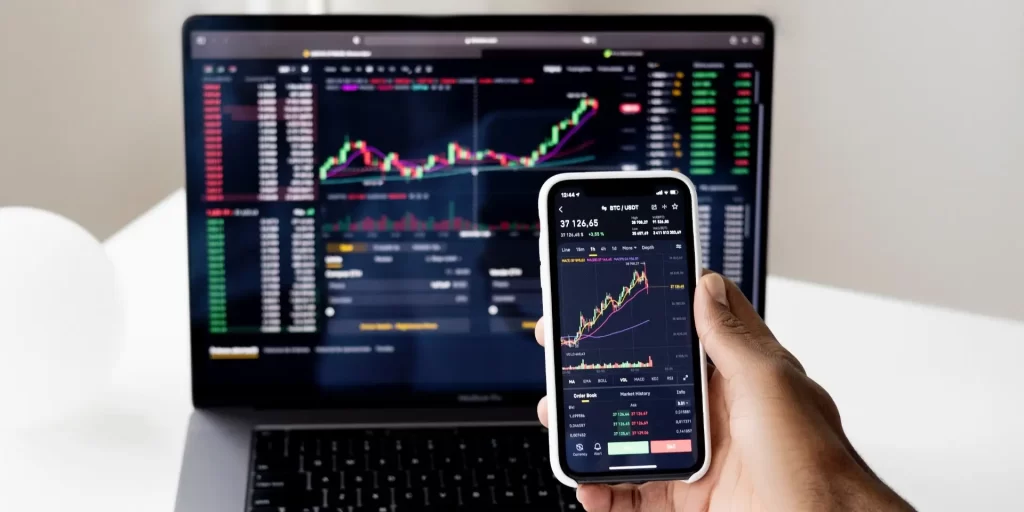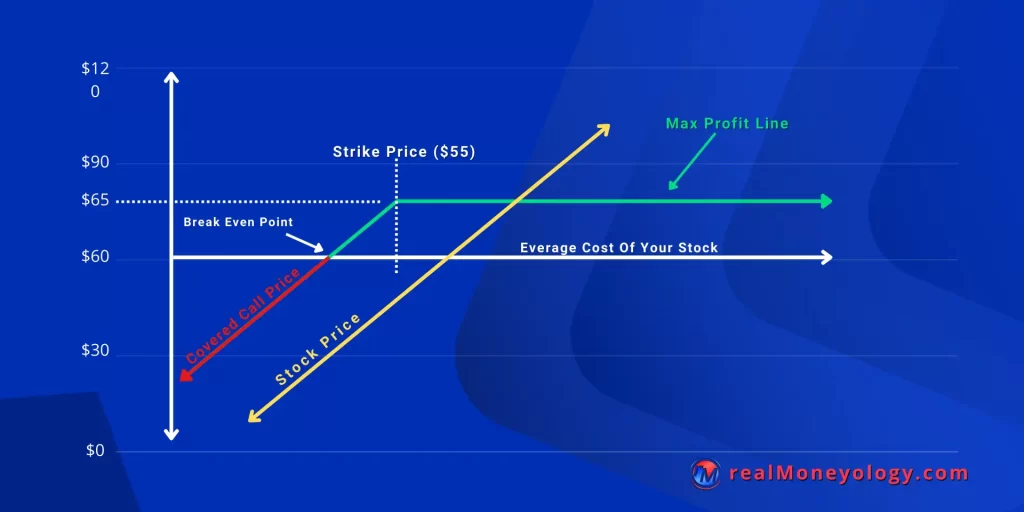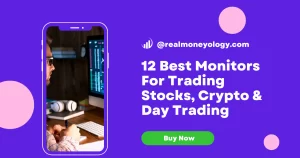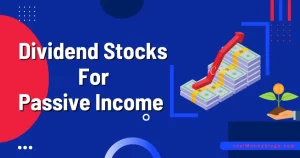Want to know what are the best stocks for covered calls where you can invest in 2023? Then, this the complete for you.
Selling a covered call is the act of writing a call option against your stock. A covered call, also known as a “buy-write” or “buy-out,”.
A covered call is usually executed for stocks in which share prices are expected to trade flat and you want to earn guaranteed returns through the premium earning of an option contract.
What are the stocks Covered Call?

A covered call is a mechanism based on options that involve a 2-fold strategy in which the trader carries out 2 simultaneous transactions one involving buying the stock and the second selling call option of the same stock.
If the investor is buying the stock and selling the call option simultaneously it is called buy-write and if the investor already holds the stock before selling the call option it is called overwrite also known as Covered Call
It means while the trader holds a long position on the stock he/she also sells call options of the same stock to generate additional income by collecting premium from call options.
In the case of stock ownership, the investor sells 1 call for every 100 shares they own at a particular strike price.
if the stock reaches the strike price or above during the expiration date the stocks covered calls obligates the investor to sell their shares at the strike price, the buyer can exercise the call options.
Therefore, if an investor wants to own his or her stocks, but also wants to generate some additional income he or she can write a covered call option on the stocks.
Example of a Covered Call
Let’s now understand the covered call mechanism with an example.
Suppose you as an investor own or decide to buy 100 stocks of company “ABC” which you feel would trade flat in the stock market for the near future.
Let’s assume the current market price of the ABC stock is $60 at which you decide to buy it. Now to execute a covered call you choose a strike price of $65 at which you sell the call option Contracts and the premium for the selling of the call option is $5.7 per share.
Remember one contract contains 100 shares, so $5.7 per share × 100 Shares = $570 total premium.

Now we are going to examine the 2 scenarios which can happen:
- Case 1: The share price of stock ABC as expected remains flat and trades below $65 till the expiry date (the day on which the option sell contract expires). As the share price is below $65 the contract won’t be executed by the other party, and you will make $570. But if the stock goes too low you will face big losses.
- Case 2: If the share price rises above $65 (Example: $65.01 or $70 or $100) then the second party will execute the contract and all your 100 shares will be sold from your trading account at $65 each ($5 profit on each stock) and plus You will earn a $570 premium amount. But if the stock went too high e.g. $80 and up you missed a huge profit.
In both cases, a covered call ensures guaranteed profits.
How to Know which stocks are Best for covered calls?
While selling covered calls is a tested and true method for long-term investors, the most challenging component is stock selection.
All covered calls trade require three choices: the underlying stock, the time period, and the strike price.
Before we move to which are the Best Stocks for Covered Calls let’s talk about different methods to pick stocks, depending on your financial objectives.
Select what you wish to own:
Let’s go through some of the crucial factors to consider while picking the underlying stock.
The majority of investors will advise you to deal exclusively with supplies that you wish to purchase.
Stocks for Covered calls are a great way to ride out any fluctuations in the market while still earning steady returns.
If you choose a stock that continues to drop, you will have difficulty generating a profit.
A critical question: Is the risk worth it?
The second thing to evaluate is whether you believe the offered premium is worth the risk.
This is the most critical component of option investing, as profit nearly always comes from being correct when the market is incorrect.
The implied volatility of a stock is the most significant proxy for market opinion towards its risk, and its options are, by definition, the price for that risk.
Therefore, if you believe that a stock’s implied volatility shows that the market is anticipating more trouble than worth, it may be a strong candidate for selling calls.
A stock’s Implied Volatility:
There are several methods for determining the current implied volatility of a particular asset. One of the earliest ways is to compare implied volatility to realized volatility in the past.
According to the idea, implied volatility will often outrun realized volatility for that time, making it beneficial to sell in the long run.
However, take care to conduct a fair comparison. If one of those terms contains an earnings release, but the other does not, the data will be skewed.
Additionally, indicators such as the IV Rating, Rank, and Percentile provide insight into how the present implied volatility compares to previous implied volatility assessments for a company.
Of course, it’s essential to keep in mind that a high IV value indicates that the market is intentionally priced for more risk.
The 10 best stocks for a covered call are as follows:
1. Johnson & Johnson (JNJ)
Business Overview: It is an American pharmaceutical company. The company was established in 1886 and is headquartered in New Jersey in the USA and manufactures health products with 130000 employees working in various parts of the globe across 60 countries and selling products in 130 countries.
The company has decided and announced to be split into 2 parts with one focusing on consumer products and the other involved in developing the pharmaceutical and medical division.
| Market Cap | 442B |
| PE Ratio (TTM) | 22.67 |
| Dividend Yield | 2.65% |
| 52 Week Range | 155.72 – 186.69 |
| Profit Margin | 20.90 |
| Total Cash (mrq) | 30.39B |
Products and Services:
The company is involved in the business of producing various health and well-being products like:
- Consumer Health products: These products are focused on covering the needs of personal health care and skin care.
- MedTech products: These products are used as part of orthopedics, surgery, Interventional solutions, and vision care.
- Pharmaceutical products: Includes various types of medicines which are used in treating cases of immunology, cardio diseases, hypertension, etc.
Subsidiaries: The company has 250 subsidiaries including Jansen Pharmaceuticals, Ethicon Inc
2. Verizon (VZ)
Business Overview: Verizon is an American telecommunication MNC. The company was founded in the year 1983 and is headquartered in the Network city of the USA. It is one of the largest communications services providers in the country.
| Market Cap | 206B |
| PE Ratio (TTM) | 9.57 |
| Dividend Yield | 5.16% |
| 52 Week Range | 45.55 – 57.39 |
| Profit Margin | 15.93% |
| Total Cash (mrq) | 1.79B |
Products and Services:
The company is involved in the various business providing telecommunications-based services, the key areas in which it operates are:
- Tech support services: It includes total mobile protection which aims to reduce the length of downtime and allow multiple devices to keep running
- Internet: Provides seamless and high-speed internet services
- Internet of Things: Establishes smart grid technologies to modernize business infrastructure
- Contact Centre and CX solutions provide services like virtual contact Centre, use of AI in customer engagement, CX consulting, and cloud contact center.
- Security and Network management: Provides private IP, internet dedicated services, virtual network services, security device management and monitoring, and cyber risk monitoring for its clients.
- Voice and collaboration
Subsidiaries: BlueJeans, Skyward, Yahoo(10%), TracFone Wireless
3. Exxon Mobil (XOM)
Business Overview: It’s an American company that operates in the space of oil and gas exploration and is involved in providing the world with energy and chemical products. Its headquartered in Irving Texas, in the USA.
| Market Cap | 404B |
| PE Ratio (TTM) | 15.94 |
| Dividend Yield | 3.67% |
| 52 Week Range | 52.10 – 105.57 |
| Profit Margin | 8.34% |
| Total Cash (mrq) | 11.07B |
Products and Services:
ExxonMobil’s business operations can be broadly divided into 3 business divisions :
- Upstream Company: It’s the main functional unit of the company which involves geologists, engineers and scientists work to find, explore, and develop oil and natural gas sites to meet the energy requirements of the world
- Low Carbon Solutions: It focuses on developing and selling low emissions energy solutions like hydrogen and other low-emission fuels.
- Product Solutions: It’s focused on developing high-quality chemical products and next-generation lubricants sustainable in nature and reducing the carbon footprint
Subsidiaries: Mobil, Imperial Oil, ExxonMobil Chemical company, etc.
4. Morgan Stanley (MS)
Business Overview: It’s an American multinational company headquartered in Midtown Manhattan in New York in the USA. The company was established in 1935 and is a financial service company
| Market Cap | 131B |
| PE Ratio (TTM) | 9.54 |
| Dividend Yield | 3.72% |
| 52 Week Range | 74.14 – 109.73 |
| Profit Margin | 24.78% |
| Total Cash (mrq) | 604.91B |
Products and Services:
Morgan Stanley operates as a financial service provider to manage capital for their clients to help them achieve maximum profitability. The financial services provided by Morgan Stanley are:
- Wealth management: It involves decisions involving how to save and invest the wealth of its clients in a manner so that one can pursue their financial goals.
- Investment banking and Capital Markets: It involves market analysis and advisory to help companies raise capital for business expansion
- Sales and Trading
- Research: it carries out research on financial markets, stocks, economies, and countries for its clients.
- Investment management: Provides investment strategies to individual and institutional investors.
Subsidiaries: Red Hat software, SoftLayer, etc.
5. IBM (IBM)
Business Overview: It is an American information technology-based MNC founded in 1911. It’s headquartered in Network in the USA while operations have spread across 171 countries with nearly 3 lakh employees.
The company has been instrumental in inventing some of the major technologies like floppy disk, hard disk drive, automated the teller machine (the ATM), the UPC barcode, and dynamic random-access memory (DRAM).
It is part of the Dow Jones industrial average.
| Market Cap | 121B |
| PE Ratio (TTM) | 22.29 |
| Dividend Yield | 4.85% |
| 52 Week Range | 114.56 – 144.73 |
| Profit Margin | 9.46% |
| Total Cash (mrq) | 10.48B |
Products and Services:
The company is involved in the business of providing its clients with computer hardware, software, and middleware. It also provides consulting and hosting services to its clients. Its product and service portfolio is listed below
The company is also working in the space of emerging technologies like cloud computing, artificial intelligence, digital workplace, cybersecurity, etc.
Subsidiaries: The company has 70 foreign branches and subsidiaries spread globally
6. Rio Tinto (RIO)
Business Overview: It is an Anglo-Australian MNC founded in 1873 and currently headquartered in London in the United Kingdom.
Since being founded the company has grown over the years through a number of mergers and acquisitions and is known as the world’s second-largest metal and mining-based company.
Its operations are spread across 35 countries globally and own open pits, mines, mills, refineries, smelters, and power stations to service facilities that are involved in producing metals.
It also owns its railway lines and ports for ensuring delivery to its clients.
| Market Cap | 112B |
| PE Ratio (TTM) | 5.21 |
| Dividend Yield | 11.52% |
| 52 Week Range | 59.58 – 89.51 |
| Profit Margin | 33.22% |
| Total Cash (mrq) | 15.29B |
Products and Services:
Rio Tinto is a mining company that mines a number of metallic products listed below
- Iron ore
- Aluminum
- Copper
- Borates
- Lithium
- Diamond
- Salt
- Titanium Dioxides
Subsidiaries : Rio Tinto, Rio Tinto Alcan, Kennecott Utah Copper, etc.
7. Pepsico Inc (PEP)
| Market Cap | 215B |
| PE Ratio (TTM) | 21.35 |
| Dividend Yield | 2.88% |
| 52 Week Range | 144.61 – 177.62 |
| Profit Margin | 12.57% |
| Total Cash (mrq) | 6.9B |
PepsiCo is a worldwide food and beverage company.
This is one of the largest and most trustworthy suppliers, PepsiCo manufactures a vast array of products that include Pepsi-Cola beverages as well other food brands such as Mountain Dew soft drinks; Gatorade sports drinks; Doritos tortilla chips & Lays potato chip aisle.
The company has a highly integrated go-to-market strategy, while it relies on third-party bottlers, contract manufacturers, and distributors in certain areas.
Along with its brands, Pepsi manufactures and sells different brands through joint ventures and collaborations with firms such as Starbucks.
The company’s activities are divided into five key geographies, with North America (Frito-Lay North America, Quaker Foods North America, and North America drinks) accounting for more than 60% of total revenue.
8. Walmart INC (WMT)
| Market Cap | 327B |
| PE Ratio (TTM) | 25.70 |
| Dividend Yield | 1.88% |
| 52 Week Range | 117.27 – 160.77 |
| Profit Margin | 2.26 |
| Total Cash (mrq) | 11.82B |
When American culture is under shock, the country frequently reverts to Walmart in several ways.
The stock is often stable due to its ability to retain sales during recessions – low-cost staples never go out of vogue.
Even if it suffers a setback, investors seeking safe havens typically cushion the blow.
Walmart demonstrated its ability to survive the COVID epidemic and Amazon’s near-complete domination in practically every other retail market during the COVID crisis.
Walmart’s stock price has never closed below the triple digits and has shown strong resistance ahead of the psychological $100 mark, which might assist protect a covered call strategy from loss.
9. Oracle Corporation (ORCL)
| Market Cap | 188B |
| PE Ratio (TTM) | 26.55 |
| Dividend Yield | 1.81% |
| 52 Week Range | 63.76 – 106.34 |
| Profit Margin | – |
| Total Cash (mrq) | 21.9B |
Oracle’s six-month chart appears to be generally consistent, except for a massive plunge below the $40 zone during March’s coronavirus market lows.
The international computer technology firm did not make significant industry headlines; it simply went about its business.
Oracle may be a very excellent covered call play if you’re looking for one.
Additionally, you can benefit from the dividend, which is now hovering around 1.75 percent.
It is usually prudent to attempt to keep the stock while selling calls to catch the bonus and add another source of income to assist offset any stock position losses.
10. Acadia Healthcare Corporation (ACHC)
| Market Cap | 5.76B |
| PE Ratio (TTM) | 23.98 |
| Dividend Yield | N/A |
| 52 Week Range | 50.07 – 76.69 |
| Profit Margin | 10.16% |
| Total Cash (mrq) | 140.37M |
Acadia Healthcare is a corporation dedicated to medical research and development. It creates and runs a network of psychiatric hospitals throughout the United States.
Hospitals, specialist treatment institutions, and more depend on this company to help their patients.
Their market capitalization is $3 billion which shows how much power they hold in the industry! It is incredibly liquid, transacting more than 1.1 million shares each day.
Acadia Healthcare earned $3 billion in sales in 2019.
When is it Appropriate to Sell a Covered Call?
When you sell a covered call, you get compensated for preceding some of the prospective upsides.
For instance, suppose you purchase XYZ stock for $50 a share to expect it to grow to $60 within a year.
Additionally, you’re willing to sell at $55 within six months, preceding further potential in exchange for a short-term profit. Selling a covered call may be an exciting option in this case.
According to the stock’s option chain, the buyer will pay a $4 per share premium when selling a $55 six-month call option.
You may sell that option against the shares you acquired at $50 and anticipate selling at $60 within a year.
You commit to selling the shares at $55 within six months by purchasing this covered call if the underlying price hits that level.
You keep the $4 premium and the $55 from the share sale, totaling $59, or an 18% return over six months.
Contrastingly, if the stock falls to $40, you will incur a $10 loss on the initial stake. However, you keep the $4 premium from the call option transaction, reducing the total loss to $6 per share from $10.
The Benefits of Covered Calls:
Selling covered call options is a smart way to make money if you are bearish on your stock.
The option will protect against potential losses and can also increase the gains by buying back shares at lower prices over time, making it an excellent investment strategy for any investor’s portfolio!
For instance, If XYZ stock closes over $59 in the example, then the seller has lost money.
The reason for this is simple: they should have just kept it themselves if their original cost was less than what you received when selling!
However, if the stock closes below $59 a share after the six-month term, the seller gets more money or loses less than if the options sale had not occurred.
The Dangers of Covered Calls:
Call sellers must maintain ownership of the underlying shares or contracts, or they will be selling naked calls, which have a theoretically limitless loss potential if the underlying security increases in value.
As a result, sellers must repurchase options holdings before expiration to sell shares or contracts, raising transaction costs while decreasing or increasing net gains or losses.
Verdict
Covered call writing can help you minimize your cost basis for stock purchases. If you own Walmart for $13,000 divided into 100 shares, your cost basis is $130.
If you decide to sell a covered call option on 100 shares for $115, your cost basis per share decreases by $1.15. As if you had purchased the shares at $128.85 rather than $130, albeit your profit potential is lost if the market climbs beyond the strike price at expiration.
Although this combination position carries an infinite adverse risk, it may be an enticing prospect if you choose income overgrowth in your investments.
It’s also worth considering if you anticipate a very stable to slightly growing market in a given stock over a specified period.







